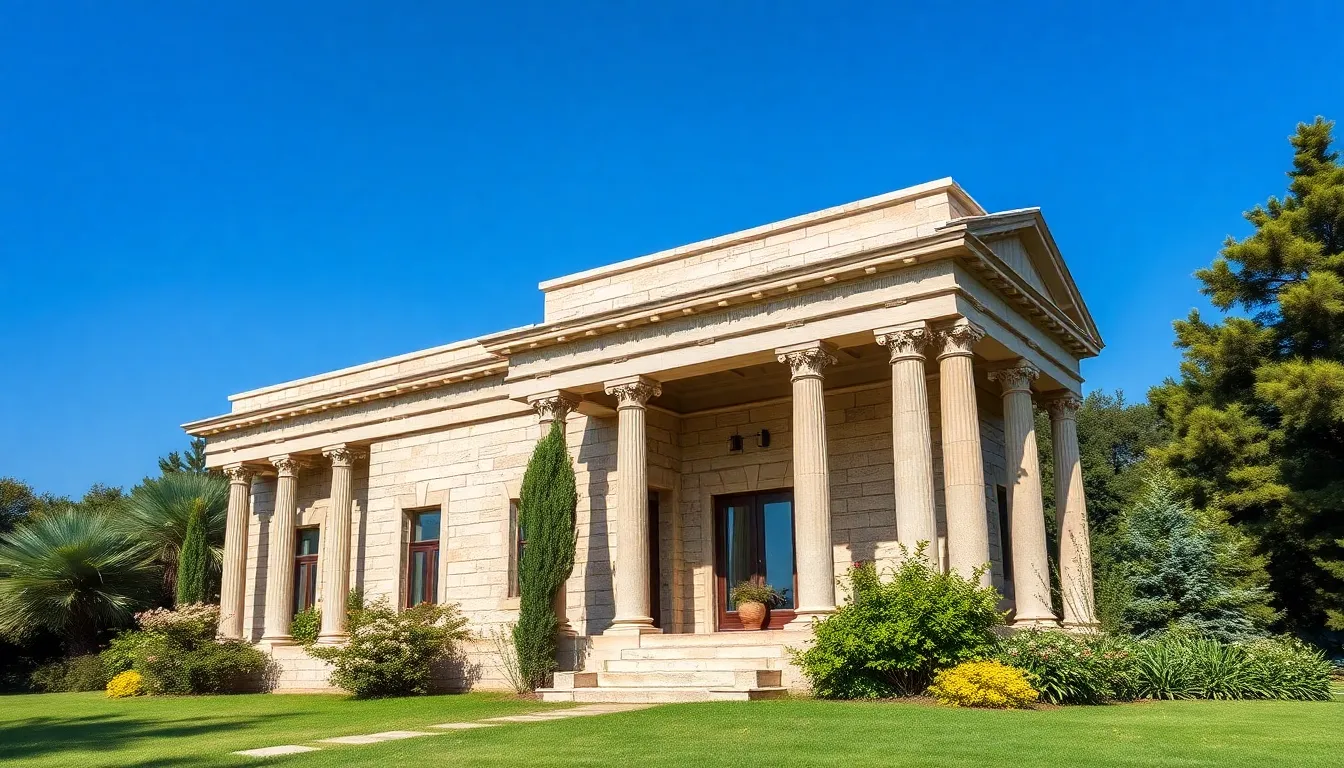Greek house architecture isn’t just about stone and columns; it’s a timeless blend of beauty and practicality that has stood the test of time. Imagine walking through a sun-drenched courtyard, surrounded by elegant structures that whisper tales of ancient civilization. From the iconic Doric columns to the intricate frescoes, these homes reflect a lifestyle steeped in culture and harmony with nature.
Table of Contents
ToggleOverview of Greek House Architecture
Greek house architecture reflects a harmonious blend of aesthetic appeal and functional design. Structures often feature large courtyards, which serve as central gathering spaces, blending indoor and outdoor living.
Columns stand as iconic elements, prominently displaying the Doric, Ionic, and Corinthian styles. These columns not only provide structural support but also add grandeur to the homes.
Traditionally, homes utilize local materials like stone and clay, showcasing durability and a connection to the landscape. Roofs are frequently flat, allowing for the collection of rainwater, a practical aspect vital in arid regions.
Windows are strategically placed to maximize natural light and ventilation, maintaining a comfortable indoor environment. They enhance airflow while minimizing heat during the hot summer months.
Frescoes decorate walls, portraying scenes of daily life, mythology, or nature. These artworks contribute visual richness and showcase the culture’s emphasis on beauty.
In many regions, homes feature simple, geometric designs, reflecting the Greek aesthetic of balance and symmetry. Privacy plays a vital role in the layout, often including high walls or secluded gardens that create personal retreats.
Modern interpretations of Greek architecture incorporate traditional elements while adapting to contemporary needs. Sustainable practices increasingly shape new buildings, continuing the legacy of environmental harmony established by ancient Greeks.
Ultimately, this architectural style endures as a testament to ingenuity and cultural identity. Its ability to adapt while maintaining core principles ensures continued relevance in modern constructions.
Key Features of Greek House Architecture

Greek house architecture embodies essential characteristics that reflect its historical and cultural context. These elements enhance both aesthetics and functionality, making them significant to understanding this architectural style.
Materials Used
Stone ranks as the primary material in Greek construction, demonstrating durability and strength. Clay plays a crucial role in creating roof tiles, which efficiently manage rainwater. Timber, utilized for beams and doors, adds warmth to structures. Lime plaster, used on walls, gives homes a polished finish. Local resources shape these materials and integrate buildings into the surrounding landscape, reinforcing the connection between architecture and nature.
Structural Elements
Columns form a vital part of Greek architecture. Doric, Ionic and Corinthian columns not only support structures but also contribute to their grandeur. Open courtyards serve as central gathering spots, merging indoor and outdoor spaces effectively. Flat roofs facilitate rainwater collection, providing essential water resources. Additionally, strategic window placement maximizes ventilation and natural light, enhancing indoor comfort during hot summers. These structural elements illustrate the harmony between beauty and utility in Greek house architecture.
Historical Development
Greek house architecture developed uniquely due to various environmental, cultural, and social influences.
Influence of Geography and Climate
Geography heavily influenced the design of Greek homes. The mountainous terrain and coastal areas required adaptation in building styles. Homes often featured thick stone walls to withstand harsh winters while providing insulation against summer heat. The use of local materials like clay tiles and limestone enabled structures to integrate into the surrounding environment. This approach maximized thermal efficiency, showcasing an understanding of climate dynamics. Open courtyards emerged as central features, allowing for outdoor living while providing shelter from sun exposure. Natural light penetrated interiors through strategically placed windows, enhancing airflow and comfort.
Evolution Through the Ages
Evolution of Greek house architecture reflects significant cultural developments. Early houses exhibited simple designs, focusing on basic functionality. As society progressed, architectural complexity increased. Roman influences introduced new elements such as vaulted roofs and expanded space. By the Byzantine period, intricate mosaics and decorative details flourished. Neoclassicism later revived classical elements, marrying tradition with elegance. Modern architecture continues to draw inspiration from these historical styles, blending ancient techniques with contemporary needs. Innovative designs incorporate sustainability, ensuring relevance in today’s world. Historical transitions demonstrate how Greek architecture adapts while preserving its rich cultural heritage.
Iconic Examples of Greek Houses
Greek house architecture features iconic designs throughout history. Notable styles reflect cultural influences, showcasing distinct characteristics that embody ancient Greek aesthetics.
The Classical Period
The Classical Period marks the height of Greek architecture, with structures that emphasize symmetry and proportion. Homes often included open-air courtyards, enhancing ventilation and natural light. Stone construction dominated this era, ensuring durability and resistance to weather. Noteworthy features include Doric columns, which provide structural support and a sense of grandeur. Additionally, frescoes adorned interior walls, depicting themes from mythology and daily life. These artistic elements enriched spaces and emphasized cultural narratives, making homes not just shelters but also symbols of identity.
The Hellenistic Period
The Hellenistic Period introduced greater complexity in design. During this time, homes increasingly featured elaborate arrangements with multiple rooms and decorative elements. Architectural variety extended beyond traditional styles, incorporating influences from conquered territories. Innovative use of space became prominent, with well-planned courtyards serving as social hubs. Moreover, the Corinthian column emerged, showcasing intricate detailing that reflected wealth and status. This era also saw enhanced use of materials, such as marble, elevating aesthetic appeal. Overall, Hellenistic homes fused function with opulence, signifying prosperity and cultural exchange.
Cultural Significance
Greek house architecture holds immense cultural importance, embracing a way of life intertwined with the natural environment. Houses often feature Doric columns that symbolize strength and order, becoming visual icons of architectural beauty. Frescoes elegantly decorate walls, narrating stories from everyday life and mythology, adding layers of cultural narrative.
Homes integrate large courtyards that serve as communal gathering spaces. These open areas encourage interaction among family and friends, reinforcing social bonds within the community. Strategic window placements optimize natural light and airflow, reflecting an understanding of climate adaptation that enhances comfort.
The choice of traditional materials such as stone, clay, and timber signifies connection to the landscape. Stone conveys durability, while clay tiles offer effective roofing, embodying practical wisdom passed down through generations. Architectural features also reflect broader historical developments, showcasing a shift from simple early designs to more intricate styles influenced by Roman and Byzantine aesthetics.
Structures from the Classical Period exemplify symmetry and proportion, focusing on balance in aesthetic and functional aspects. The emergence of the Corinthian column during the Hellenistic Period introduces elaborate designs that reflect wealth and social status. Each era contributes distinct elements, illustrating a fusion of innovation and tradition in domestic architecture.
Cultural exchange marks the evolution of Greek housing styles, incorporating diverse influences while maintaining a clear identity. This adaptability is evident in modern applications, where principles from ancient designs inspire sustainable practices today. Greek house architecture remains a testament to rich cultural heritage, ensuring its significance in contemporary construction practices.
Greek house architecture stands as a remarkable testament to the blend of beauty and functionality. Its enduring elements reflect a deep connection to nature and culture, showcasing how design can enhance everyday life. The iconic columns and spacious courtyards not only serve practical purposes but also elevate the aesthetic experience of the home.
As modern architecture continues to evolve, the principles rooted in Greek design remain influential. By embracing sustainability and integrating historical elements, contemporary builders honor this rich tradition. Greek house architecture is more than just a style; it’s a narrative of human experience that continues to inspire and resonate today.


